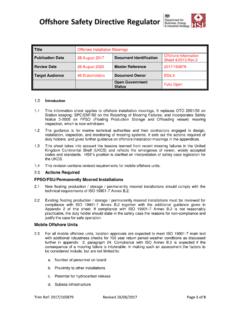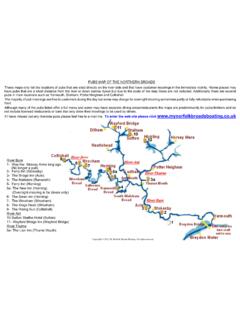Transcription of THE MOORINGS TONGA WEATHER FORECASTS VAVA’U …
1 THE MOORINGS TONGA VAVA U ISLANDS CRUISING GUIDE THE MOORINGS BASE The MOORINGS base in Vava u is designed and operated as a bareboat base. TONGA s laws do not permit work on Sundays so an emergency stand-by service is maintained on the day only. Normal services are maintained during the rest of the week. There are swing MOORINGS located off the MOORINGS base at Neiafu but all other MOORINGS in the group is by anchor. Embarkation and disembarkation is normally scheduled with the arrival and departure of international or inter island commuter flights or as arranged by booking.
2 WEATHER The WEATHER in Vava u is controlled by trade winds blowing from the south east at an average of 12 knots. Temperatures range from 21 C in July to 30 C in February. From January to March the wind becomes more variable, humidity and rainfall increases, however the sailing conditions remain favourable. There is occasional strong Northwest winds with rain, normally clearing within 12 hours, with wind shifting to the south. Hurricanes are not a worry since Vava u offers adequate forecasting and excellent protection. It is over 14 years since the last hurricane. TIDES The main tide rise and fall is 1 metre.
3 Tide tables are standard on all MOORINGS yachts and should be consulted when planning the daily cruise. Tides can cause strong currents in narrow passages. During the periods of strong winds from a constant direction surface currents will build up. When steering a compass course, be aware that these currents may set you off your intended course. When going ashore make sure the dinghy is well above high water mark and use the dinghy anchor on the beach to prevent a rising tide from floating the dinghy off the beach. WEATHER FORECASTS Radio Nuku alofa: Dial 1017 kHz on the AM band.
4 WEATHER FORECASTS follow the BBC news at 0700 and the Australia news at 0800. VHF Channel 10: Vava u Marine Radio transmit the WEATHER forecast at 1030 and 1530 daily apart from Sunday. VHF Channel 6: This is the cruisers net which operates a general information service at 0830 each morning apart from Sundays. The WEATHER if often discussed at great length on this channel in the mornings. RADIO PROCEDEDURES MOORINGS monitors VHF channel 68 during office hours from 0800 to 1700 hours daily. Call MOORINGS at any time during these hours and usually someone will be close at hand to reply.
5 If you don t reach us on the first try, wait a short while and try calling again. If you wish to call another MOORINGS yacht call on 68 then change to 6, 14, 73 or 77 so that 68 is kept clear for other communications. Channel 16 is monitored onshore by the Vava u Port Service and many of the cruising yachts may also monitor this channel. MOORINGS request that their clients call each day between 1600 and 1630 hours to advise that they are anchored and their location. At that time we will be able to inform you of any salient WEATHER information or notices to mariners that we might have to hand.
6 In the event of an emergency and you are unable to contact us on the VHF continue to broadcast your location and problem. At times we are able to hear you when you may be unable to receive us. Our VHF radio range is approximately 25 miles covering all the anchorages in the Vava u group. Occasionally we get radio shadows at anchorages #7 and #13. Communications are possible even though there may be some breaking up of the signals. SERVICE CALLS Should your yacht need service due to mechanical or rig problems, call us on channel 68 on the VHF to give us details. We can attend to such problems quickly if you can get to the nearest of the following anchorages: 5, 10, 11 or 25.
7 We have road access to these points and can be with you in a matter of minutes if you have informed us of the nature of your problem and your intended anchorage. ANCHORING Most anchoring will be done at depths of 5m to 15m. Depths over 20m are not recommended. Virtually all the anchorages have visibility beyond such depths and it is easy to check for coral heads. Snorkel over your anchor to check for a proper set. Use normal anchoring techniques with scope of 3 times the depth for all chain rodes and 5 to 7 times the depth for chain and rope ropes. When using a plough anchor wait until the yacht is head to wind then check the anchor set by backing with a slow reverse pull back from your engine.
8 Should your anchor get stuck shorten the rode to neat vertical position and fasten it off the one of the cleats. Try to break the anchor out with the yacht in forward gear at slow engine speed. Do not make the rode fast to the windlass. If you are unable to break out the anchor make careful note if its position, tie a fender and a mooring line to the end of the entire anchor, chain and rode and advise us by VHF. We will send a diver to retrieve it. In unsettled waters with strong wind conditions use more than the usual scope. It may be prudent in some circumstances to use a second bow anchor, having the two anchors off the bow at 45 angle to each other.
9 The second anchor is a Danforth which has very good holding characteristics particularly in coral. When the WEATHER improves shorten the rode to prevent excess line fouling the coral heads. You will find that anchorages numbers 10, 16 and 25 make good all WEATHER anchorages. FISH AND POSSIBLE HAZARDS Many fish can be caught and most make excellent eating. TONGA is fortunate not to have any fish-poisoning problems. However, when fishing in any unfamiliar area it is best to check with the local inhabitants before consuming your catch. Due to Tongan beliefs there is to be no fishing on Sundays anywhere in TONGA .
10 There are few hazards in the sea, as indicated by the many Tongans that you see swimming, however normal caution justifies 1. Do not swim where fish have been cleaned or near garbage. Do watch out for sea urchins as their sharp spines can inflict a painful wound. Stonefish are very poisonous but fortunately are not very common. The stone fish is normally about 10 inches long, rests on the bottom, resembles a rock and has 13 venomous spines on its back. Similarly, Sea Snakes are a rare problem. They are about 12 inches long, have black and white stripes and bask on the surface in shallow, warm water.






